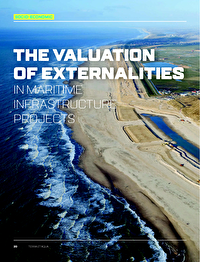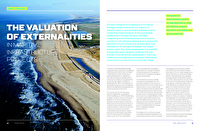The need for sustainable development was initially promoted during the first United Nations (UN) conference on the Human Environment in 1972 (Smardon, 2008). The definition of sustainable development is, ‘development that meets the needs of the present without compromising the ability of future generations to meet their own needs’ (United Nations General Assembly, 1987). The consideration of intergenerational equity is one of the essential features that separates sustainable policy from a traditional approach (Emas, 2015).
The international maritime industry is a significant stakeholder in sustainability compliance (Wang et al., 2020). Besides being a catalyst industry for economic activity and globalisation, maritime industry activities create environmental, social, and economic externalities that should be accounted for to understand the actual value these projects provide to society. Furthermore, the maritime infrastructure industry is one of those industries where appropriate planning can significantly improve project sustainability since the timeline required to complete a project is often long. Thus, improvements in the initial project planning related to sustainability can increase the likelihood of project acceptance by the regulative authorities continuously working towards being more sustainable.
The improvement required to increase the quality of project assessment in exante project evaluation is the inclusion of externalities that the maritime infrastructure projects create. Inclusion of externalities refers to the assurance that all related project benefits and costs are accounted for (Ding et al., 2014). Such evaluations are also known as ‘green accounting’ because they include all sources of future growth (Weitzman, 2016). The project-specific externalities can be best internalised and accounted for in the project valuation by considering the three sustainability pillars: economic, social and environmental (Kastenhofer and Rammel, 2005; United Nations General Assembly, 2005).
Businesses still find it difficult and costly to include all the externalities based on the sustainability pillars due to a lack of available methodology to do so efficiently. De Boer et al. (2019) note that the externalities are accounted for only if an impact assessment is required. Moreover, during the project stage at which these assessments are necessary, the project design is already fixed (Laboyrie et al., 2018). If externalities are not accounted for during the initial design stage, the approval of the regulator is less likely (Laboyrie et al., 2018). Additionally, businesses may not be aware of all the externalities encountered in a particular project since incorporation of externalities requires multidisciplinary expertise. Thus, there is a benefit to the industry from awareness about the holistic effects of infrastructure projects. There exist methodologies that include externalities that the infrastructure projects create and, in such a manner, estimate the actual value of the project. Use of the ex-ante evaluation of maritime infrastructure projects could lead to better management of environmental, social and economic externalities, and thus improve the sustainability of the maritime industry.
This study provides a comparison of available valuation methods by answering two questions: 1) What are the sustainable project valuation methods currently available; and 2) Which methods are the most suitable for evaluating externalities in maritime infrastructure projects?
The first question is answered by employing secondary research and contacting owners of methodologies for additional information that is not publicly available. The second question is answered through a comparison study conducted using the Analytic Hierarchy Process (AHP) framework, which was introduced by Thomas Saaty (1977) as a tool for Multi-Criteria Decision Making (MCDM). Furthermore, these results will be tested using a case study of the Hondsbossche and Pettemer (H&P) sea dyke, a maritime infrastructure project reinforced in 2015 at the Dutch seaside.















